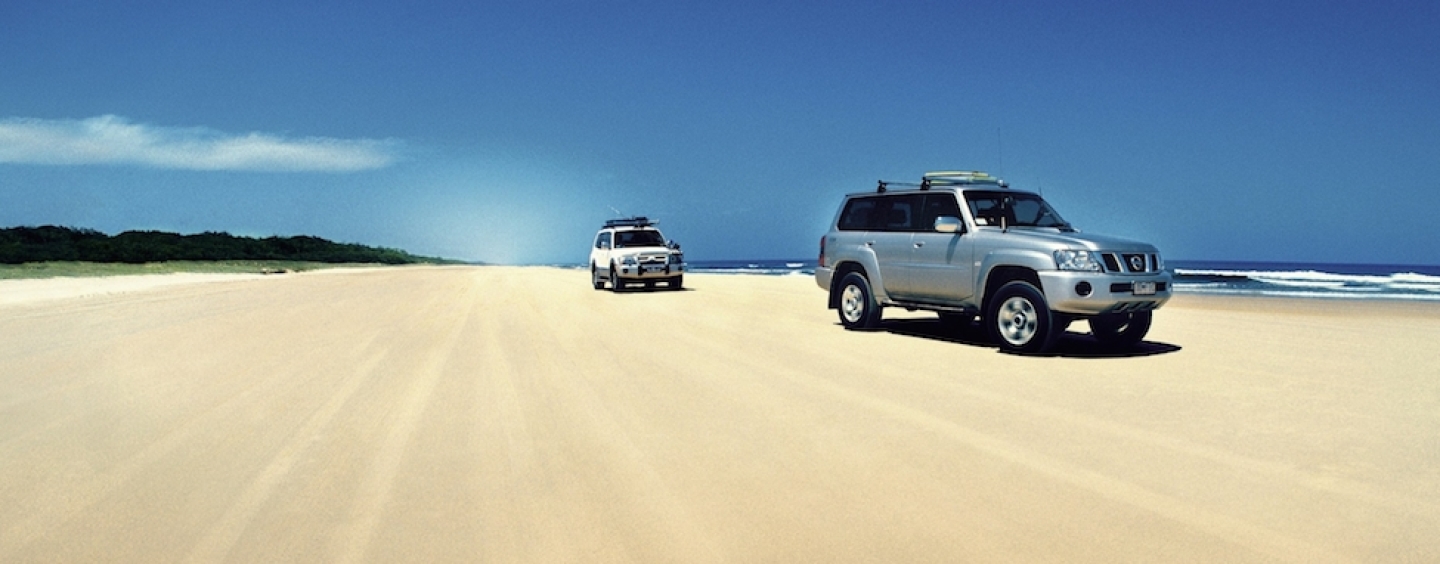Driving on the sand is a very exciting experience for the entire family when discovering remote parts of the country. Cruising up the beach with the windows down, the sound system blaring, and the wind blowing in your hair, make for a memorable family vacation.
In South East Queensland, newcomers to 4×4 driving will usually have their first off-road experience on sand. However, if you get it wrong, you may be hours away from help while placing those you love in serious danger. Without the right knowledge, a debut on sand can lead to disasters such as getting stuck in quicksand, rolling your car down a dune, or even floating away with the tide.
Driving on sand requires special care. The driver must be prepared for the ever-changing sand environment. By following the tips set out below, you will help protect these areas, and have a safe enjoyable visit.
Research your location
In Australia, most beach driving locations are well documented by your car hire company. The local council and tourist information websites, and other online resources outline in detail which beaches permit the use of vehicles. At more popular locations, there will be clearly marked access routes and signage explaining where you can and cannot go. To avoid unnecessary damage to the already fragile ecosystems, it is advisable to use established access routes, which are typically better options for your vehicle. Pay attention to signs, avoid night driving, and remember that not all beaches are safe to drive on.
Prepare your Vehicle
The lighter your 4WD, the less likely it will be stuck in soft sand. Reduce your load by removing any objects, fixtures or fittings that will not be required for the trip. Load your vehicle evenly, with heavy items stored low. Uneven or heavy loads on roof racks can cause a vehicle to roll over. By packing smart, it will be easier to have your passengers alight and to offload your gear from the vehicle before driving out of a sticky situation.
You need adequate distance under your vehicle. Do not bottom out on the crests, which will cause you to slow and become bogged. The clearance between the ground and underside of the car should be greater than 18cm.
You can lower your tyre pressure to increase the surface area making contact with the sand. This will provide better traction on slippery surfaces. For most 4WD vehicles that have a recommended road driving pressure of 32-38psi, you can lower pressure to 25psi, but not lower than 18psi. Note that some sand driving areas around Australia require an even lower tyre pressure, so it is best to research advice about each location. Be mindful that low tyre pressure means the vehicle will respond differently, such as delay in steering and braking response times. Remember to always re-inflate your tyres to the recommended pressure when you drive back on sealed surfaces.
Before you drive onto the sand, engage locking hubs and 4WD. While driving, select low gears for soft, dry sand, and avoid sharp turns and sudden braking.
Be Prepared for whatever
Driving on the sand will require you to be constantly alert for potential hazards. Check the times for low tide using a tides chart. You should travel on the sand at low tide, or within two hours either before or after low tide. This is the best time, as the sand will be firm and you will have time to reach your destination. You should choose a driving line on the harder sand between the waterline and the high tide mark. Avoid the salt water.
Take care in crossing creeks and streams where you may become stuck. Before crossing, it is best to check the depth of the water by walking across the creek. While driving with your 4WD, never stop mid-stream to avoid getting stuck.
Sand does not provide much traction. To avoid becoming bogged, you must maintain a momentum or be slightly increasing your speed. If you do become stuck, which is inevitable, accept this fact as part of your off-road experience. You should have all the essential recovery equipment to help get you out, such as a shovel, a towrope, a snatch strap, shackles, traction tracks, a winch, a lift jack, and a compressor.
Obey the rules
Even if the surface you are driving on may be different, the normal road rules apply on the beach and on inland tracks. Never drive tired or under the influence of alcohol or drugs. Use your indicators when overtaking or turning. Keep to the left of oncoming traffic. All persons in the vehicle must wear seatbelts at all times. The speed limits apply on beaches, so know what they are, while you obey the road signs.
You are driving on the sand for fun and recreation, so make it an enjoyable and positive experience by being overly courteous to others. Keep a safe distance behind other vehicles. Always give way to traffic coming downhill. Heavy vehicles and those with trailers have right-of-way in most situations. Always use the passing bays provided, and slow down and drive carefully where there are pedestrians.
Be mindful of the environment you are in. Respect flora and fauna in the area. It is illegal to drive across sand dunes or over coastal vegetation. Drive slowly around, not through, flocks of birds. Beaches and dunes are important breeding and roosting sites for birds. Be aware, from November to March the sand dunes along the southeast coastline are nesting and hatching sites for green and loggerhead turtles. If you are approached by dingoes, stay in your vehicle.
Driving on the beach is a wildly exciting way to enjoy the coastlines. Your primary responsibility is to ensure that you and your passengers are safe. Take your time and operate your vehicle mindfully to avoid injury, while enjoying the wonders of the natural surroundings.
In an emergency Dial 000. If no mobile reception, try 112. Carry a well-stocked first-aid kit and know how to use it.
By Andy Kancachian, with information from Queensland Government, Department of National Parks, Sport and Racing.
(Feb-Apr2017)



























